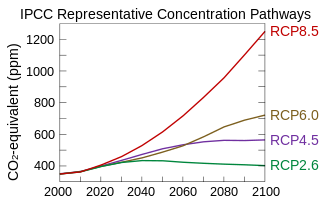
Representative Concentration Pathways (RCP) are climate change scenarios to project future greenhouse gas concentrations. These pathways (or trajectories) describe future greenhouse gas concentrations (not emissions) and have been formally adopted by the IPCC. The pathways describe different climate change scenarios, all of which were considered possible depending on the amount of greenhouse gases (GHG) emitted in the years to come. The four RCPs – originally RCP2.6, RCP4.5, RCP6, and RCP8.5 – are labelled after a possible range of radiative forcing values in the year 2100 (2.6, 4.5, 6, and 8.5 W/m2, respectively).[1][2][3] The IPCC Fifth Assessment Report (AR5) began to use these four pathways for climate modeling and research in 2014. The higher values mean higher greenhouse gas emissions and therefore higher global surface temperatures and more pronounced effects of climate change. The lower RCP values, on the other hand, are more desirable for humans but would require more stringent climate change mitigation efforts to achieve them.
In the IPCC's Sixth Assessment Report the original pathways are now being considered together with Shared Socioeconomic Pathways. There are three new RCPs, namely RCP1.9, RCP3.4 and RCP7.[4] A short description of the RCPs is as follows: RCP 1.9 is a pathway that limits global warming to below 1.5 °C, the aspirational goal of the Paris Agreement.[4] RCP 2.6 is a very stringent pathway.[4] RCP 3.4 represents an intermediate pathway between the very stringent RCP2.6 and less stringent mitigation efforts associated with RCP4.5.[5] RCP 4.5 is described by the IPCC as an intermediate scenario.[6] In RCP 6, emissions peak around 2080, then decline.[7] RCP7 is a baseline outcome rather than a mitigation target.[4] In RCP 8.5 emissions continue to rise throughout the 21st century.[8]: Figure 2, p. 223
For the extended RCP2.6 scenario, global warming of 0.0 to 1.2 °C is projected for the late 23rd century (2281–2300 average), relative to 1986–2005.[9] For the extended RCP8.5, global warming of 3.0 to 12.6 °C is projected over the same time period.[9]
- ^ "Representative Concentration Pathways (RCPs)". IPCC. Retrieved 13 February 2019.
- ^ Richard Moss; et al. (2008). Towards New Scenarios for Analysis of Emissions, Climate Change, Impacts, and Response Strategies (PDF). Geneva: Intergovernmental Panel on Climate Change. p. 132.
- ^ Weyant, John; Azar, Christian; Kainuma, Mikiko; Kejun, Jiang; Nakicenovic, Nebojsa; Shukla, P.R.; La Rovere, Emilio; Yohe, Gary (April 2009). Report of 2.6 Versus 2.9 Watts/m2 RCPP Evaluation Panel (PDF). Geneva, Switzerland: IPCC Secretariat.
- ^ a b c d "Explainer: How 'Shared Socioeconomic Pathways' explore future climate change". Carbon Brief. 2018-04-19. Retrieved 2020-03-04.
- ^ Cite error: The named reference
:1was invoked but never defined (see the help page). - ^ Cite error: The named reference
ReferenceAwas invoked but never defined (see the help page). - ^ Cite error: The named reference
:2was invoked but never defined (see the help page). - ^ Cite error: The named reference
:0was invoked but never defined (see the help page). - ^ a b Cite error: The named reference
collins 23rd century projectionswas invoked but never defined (see the help page).